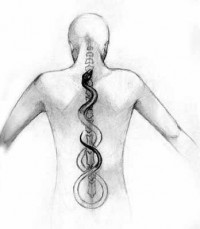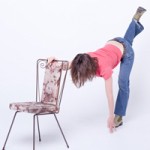Meditation is a cumulative experience.
That is, the more you do it, the more you get it, the more you want to do it, the more you get out of it… creating this constant feedback loop of encouragement.
Unfortunately, it also works the other way.
We begin to meditate, never having done it before, likely with many expectations of what meditation is “supposed” to be like.
We come up hard against these expectations. We come up against our mind. We come up against our sore legs and fidgety body. We don’t know if we’re doing it “right”. And so we quit.
Waste of time anyway, this sitting around doing nothing business.
But like anything in life, meditation takes cultivation.
And like anything we do, it’s helpful to have no expectations at all. To just be present with whatever is.
And what is when we start may be a whole lot of thought, fidgeting, anxiety, resistance and even nasty feelings. It’s all part of the process.
After all, if you’d inherited a parched block of dusty dirt and wanted to create a lush garden, you wouldn’t just toss a few seeds on the ground and then start complaining that they didn’t grow, would you?
No. You’d spend time preparing the soil, finding out what type of plants are best suited to that climate, planting seeds & seedlings, nurturing & watering them, pruning & cutting back. The first year your harvest might be so-so. But by the second or third, your garden would be flowering and fruiting in abundance.
This is the path of meditation.
It’s one I began a long time ago, in haphazard ways. But it’s something I have spent a lot of time doing over the years. I do it all the time now. On the bus, walking, driving…
Now, when I sit down to do twenty minutes of loving-kindness meditation, I’m able to sink down into a still state of awareness with ease. I’m aware of the three central spinal nadis along which prana flows – ida, pingala and sushumna. I can sense prana wending it’s way along these nadis, and many of the other 72,000 pathways within the body.
This yogic description of the way energy moves around the body – prana flowing through 72,000 different nadis, which create “wheels” at the places where many nadi intersect, i.e. chakras… it’s not metaphoric. It’s experiential. That is, spend enough time in meditation and you will sense the flow of prana with in, and you will sense the pathways that it flows along.
Being aware of this is largely a process of surrender, of dropping down into the experience and letting prana do it’s thing, seeking out knots and tension and dissolving them away.
As this process unfolds within my awareness, another part of me is reciting the four lines of meditation over and over and over. If I begin to identify too much with the movement of prana, I lose where I am with the lines, and it’s a reminder to come back to that place of witnessing.
Usually by the end of the twenty minutes, I can feel prana rising unimpeded up through the central spinal channels, from about anahata chakra up towards anja chakra. At times I even feel the cycling back and forth between the chakras that you see in illustrations of Kundalini Rising. Prana really does do this. About at anja chakra I sense a block, kinda like a pot lid sitting over top of a chimney. But even that pot lid seems to be moving slowly upward towards the crown of my head.
All of this phenomena is, in and of itself, nothing at all. It is like the rain falling from the clouds, the sun burning up the morning mist, the thunder rolling in from the hills. It’s just what life force does within our body once it’s activated. Nothing special.
Yet to be aware of this, to watch the process, gives me a sense of the world – of reality – being far greater than we generally like to perceive.
We are not separate discrete beings walking on this planet. We are all part of one giant unified field of consciousness. And I feel this in meditation. A melting of my perceived exterior boundaries of skin and flesh, and an opening into all that is.
So how does this meditative experience translate over into day-to-day living?
More and more, I am beginning to understand that people lash out at others when they feel hurt within themselves. It’s just what we do when we’re unaware. The pain is so damn awful and we don’t want to feel it do we suck it up in our words and spit it out at those closest to us.
Realizing this helps me to get to a place where I don’t take those words personally. What you say to me is all about you and where you are at – not me. And that includes whether you praise me or condemn me. Neither has anything to do with my stillness within.
Your words reveal to me what’s going on inside of you, and while those words can be nasty and hurtful, or perceived as an attack on the self, in reality, there is no “self” you can attack. Meditation teaches this, just as it teaches us not to react to the words and hurt.
Just being aware of something allows it to be… and then to dissipate. When you listen with awareness to someone, you literally allow them to get “something off their chest”, as you hold the awareness which allows that “something” to melt away. aAwareness is a circuit breaker really, which interrupts the great drama of life. It’s even more powerful when you can respond with loving-kindness.
I like to think of how the Dalai Lama, or Buddha, or Jesus would respond to someone who’d say… thought they’d been cut off in traffic and launched into a road rage tirade. Hard to imagine any of them fighting/arguing back. In my imagination, they’d simple listen with awareness to what was said, and respond with a smile and maybe a gentle word or two of compassion.
These are just some of the impressions, understandings and experiences that are coming up for me in meditation, and as a result of meditation. It’s inspiring me to continue, and to “work” harder even…yes, the more I do, the more I want to do, the more reward, the more I do…
Eleven days to go until this meditation is complete!


Meditation is the doorway to understanding of self and inner peace. Unfortunately, as you note, it takes cultivation. Too many of the more popular new age authors portray every form of meditation as something that can be mastered quickly, with very little effort. Perhaps they have a gift for meditation. But for most of us, it is not easy. There may well be a good bit of discomfort. This is especially true if we are overwhelmed by negative life experiences and our own destructive habits. The key for such individuals is just to start and then find the help and support to continue. It is in persevering that the real benefits of meditation are found.
Hey Brice,
I’m with ya – meditation rocks!
But yep, persistence is key.
Blessings,
Kara-Leah
A helpful article….thank you.